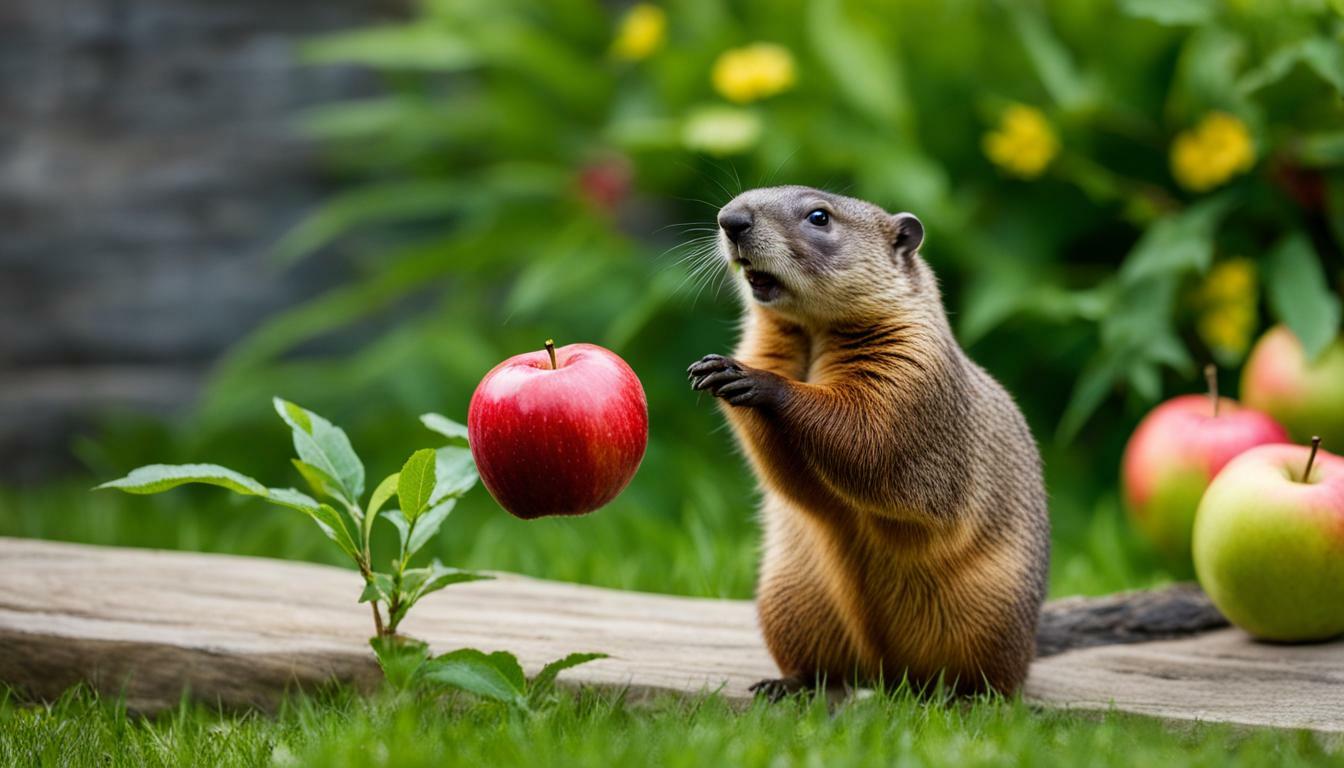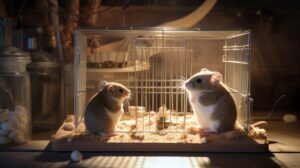If you’re wondering, “Can groundhogs eat apples?” you’ll be pleased to know that these backyard pals actually enjoy this fruity treat.
Groundhogs are herbivores, but they can be quite adaptable when it comes to their diet. While they primarily eat plants, vegetables, and fruits, including apples, they also have a taste for small insects like June bugs, grasshoppers, and snails.
Key Takeaways:
- Groundhogs can eat apples and consider them as one of their favorite foods.
- They grab and bite into apples but usually don’t eat the whole apple, leaving some parts to rot.
- Groundhogs primarily eat plants, vegetables, and fruits like apples, pears, berries, and cherries.
- They are adaptable and can change their diet depending on the season and availability of food.
- It is recommended to provide a variety of fruits and vegetables throughout the year to meet their nutritional needs and keep them satisfied.
Groundhog Diet and Adaptability
Groundhogs are primarily herbivores, but they can adapt their diet based on the availability of food. They have a diverse range of dietary preferences and can consume a variety of plants, vegetables, and fruits.
When it comes to their nutrition, groundhogs are known to be flexible in their food choices.
Their diet consists of plants such as grass, clover, and dandelion leaves, which are commonly found in their natural habitat.
Groundhogs also have a penchant for fruits like berries, cherries, pears, and, of course, apples. These furry creatures are especially fond of apples and will often munch on them.
However, it’s worth mentioning that groundhogs usually don’t eat the entire apple, leaving some parts to rot.
Groundhogs’ eating habits are unique and interesting. They typically grab an apple and take a bite, relishing the juicy goodness.
They seldom eat the entire fruit, leaving the remaining portion to decay. This behavior might seem peculiar, but it is a common trait among groundhogs.
Groundhogs as Adaptable Eaters
Groundhogs have the ability to adapt their diet to seasonal changes and the availability of different foods.
For example, during the warmer months, when vegetation is abundant, they rely heavily on plants, leafy greens, and various types of fruit.
In contrast, during the colder months, when food sources become scarce, groundhogs adjust their diet and become less selective, consuming bark, roots, and other woody materials found in their burrow surroundings.
It’s important to note that groundhogs’ adaptability doesn’t end with food choices. These resilient creatures are also known for their ability to adapt to different environments and climates, making them well-suited for survival in various habitats.
| Groundhogs’ Preferred Foods | Groundhogs’ Seasonal Diet |
|---|---|
|
|
Apples as a Favorite Food for Groundhogs
Apples are actually one of the favorite foods for groundhogs, and they eagerly bite into them. These adorable creatures love the taste and texture of apples, making them a delightful addition to their diet.
Groundhogs are herbivores by nature, primarily feeding on plants, vegetables, and fruits. Apples, with their sweet and juicy flesh, are a treat that groundhogs simply can’t resist.
When it comes to feasting on apples, groundhogs have a unique way of consuming them. They tend to grab and bite into apples but rarely eat the entire fruit.
Instead, they leave parts of the apple to rot. It may seem peculiar, but this behavior is actually a part of their natural feeding habits.
By allowing the apples to decompose, groundhogs contribute to the natural decomposition process and help enrich the soil.
Groundhogs’ Versatile Palate
While groundhogs have a special fondness for apples, their diet extends beyond this delightful fruit. They are known to indulge in a variety of other fruits, including pears, berries, and cherries.
These fruits provide essential nutrients and hydration for groundhogs, ensuring their overall health and well-being.
Additionally, groundhogs sometimes supplement their plant-based diet with small insects like June bugs, grasshoppers, and snails.
Groundhogs’ food preferences and diet can vary depending on the season and the availability of certain foods.
As opportunistic eaters, groundhogs are adaptable and can adjust their diet to suit their surroundings. However, their love for apples remains consistent throughout the year.
Whether it’s crisp autumn apples or the juiciest summer varieties, groundhogs will always appreciate a tasty apple as a part of their meal.
| Groundhog Food Preferences | Examples |
|---|---|
| Fruits | Apples, pears, berries, and cherries |
| Vegetables | Carrots, lettuce, and cucumbers |
| Plants | Dandelions, clover, and grass |
To keep groundhogs satisfied and well-nourished, it is recommended to provide a varied diet that includes a mix of fruits and vegetables.
This ensures they receive the necessary nutrients and helps prevent them from wreaking havoc in gardens and orchards.
By offering a diverse selection of foods throughout the year, you can keep these furry garden visitors content and minimize their impact on your crops.
Apples and Groundhog Feeding Habits
Groundhogs have a tendency to grab and bite into apples, but they don’t usually eat the whole fruit, leaving behind some parts to decompose.
This behavior may seem wasteful, but it actually serves a purpose. Groundhogs are herbivores and need a diverse diet to meet their nutritional needs.
By leaving parts of the apple to rot, they are not just being picky eaters; they are contributing to the ecosystem by aiding in the decomposition process.
When groundhogs consume apples, they primarily focus on the flesh and seeds while leaving behind the apple core and skin.
This feeding habit allows them to extract the most nutrients from the fruit while discarding the parts that are less nutritious.
It’s fascinating to observe how they interact with apples, as they use their sharp teeth to bite into the fruit and enjoy the juicy goodness inside.
While apples are safe for groundhogs to eat, it’s important to note that they should not be the sole component of their diet.
Groundhogs have a versatile palate and consume a variety of plants, vegetables, and fruits. To ensure their nutritional needs are met, it is recommended to provide a balanced diet that includes a mix of fruits, vegetables, and other forageable items throughout the year.
Groundhog Diet Versatility
Groundhogs have a diverse diet that includes not just apples, but also other fruits, vegetables, and plants.
These herbivores have an adaptable palate and can adjust their food choices depending on the season and the availability of certain foods.
While they primarily consume plants, groundhogs are known to have a fondness for various fruits, including apples, pears, berries, and cherries.
When it comes to apples, groundhogs enjoy biting into them, but they often don’t eat the whole fruit. Instead, they leave some parts to rot, as their feeding habits involve nibbling on various food sources.
This behavior can be observed in their consumption of other fruits as well. However, groundhogs’ diet is not limited to fruits alone; they also incorporate a range of vegetables and plants into their meals.
In addition to their plant-based diet, groundhogs occasionally supplement their meals with small insects like June bugs, grasshoppers, and snails.
This behavior further highlights their versatility in finding food sources. However, it’s important to note that while groundhogs can consume a variety of foods, they can also cause trouble in gardens and orchards by raiding vegetable crops and fruit trees.
| Fruits for Groundhogs | Vegetables for Groundhogs | Plants for Groundhogs |
|---|---|---|
| Apples | Carrots | Clover |
| Pears | Broccoli | Dandelion leaves |
| Berries | Cabbage | Grasses |
| Cherries | Kale | Violets |
To ensure that groundhogs receive proper nutrition, it is recommended to provide a balanced diet that includes a variety of fruits and vegetables throughout the year.
This not only meets their nutritional needs but also keeps them satisfied, reducing the likelihood of them causing damage to gardens and orchards.
By understanding their diet versatility and preferences, we can coexist harmoniously with these fascinating creatures.
Groundhog Interactions with Gardens and Orchards
Unfortunately, groundhogs’ love for fruits and vegetables can sometimes lead to conflicts with gardeners and orchard owners.
These furry creatures have a fondness for raiding vegetable crops and fruit trees, leaving gardeners frustrated and orchard owners worried about their harvest.
Groundhogs, also known as woodchucks, are herbivores that primarily feed on plants, vegetables, and fruits.
Apples, pears, berries, and cherries are among their favorite foods, and they eagerly devour these delectable treats.
They grab and bite into apples, but interestingly, they tend not to eat the whole apple, often leaving some parts to rot.
It’s important to note that groundhogs are adaptable animals and can change their diet depending on the season and the availability of certain foods.
While they enjoy indulging in fruits and vegetables, their dietary preferences may vary depending on what is accessible to them.
Managing Groundhog Interactions
To prevent groundhogs from wreaking havoc in gardens and orchards, several strategies can be employed.
One approach is to create physical barriers such as fences or netting to protect crops and trees. These barriers should be buried underground to prevent groundhogs from digging underneath them.
Another option is to use natural deterrents to discourage groundhogs from entering the garden or orchard.
Planting aromatic plants like mint, garlic, or marigold can help repel these curious critters. Additionally, regularly removing fallen fruits and vegetables from the ground can minimize their attraction to the area.
| Deterrents | Effectiveness |
|---|---|
| Fencing | Highly effective |
| Aromatic plants | Moderately effective |
| Regular clean-up | Moderately effective |
By implementing these management strategies, gardeners and orchard owners can minimize conflicts with groundhogs while still appreciating the presence of these fascinating creatures in their surrounding environment.
Providing a Balanced Diet for Groundhogs
To keep groundhogs healthy and satisfied, it’s essential to offer them a variety of fruits and vegetables throughout the year.
Groundhogs are herbivores with a preference for plants, vegetables, and fruits. They have a diverse diet that includes apples, pears, berries, cherries, and more.
These furry creatures enjoy grabbing and biting into apples, but they typically don’t consume the entire fruit, often leaving some parts to rot.
This behavior contributes to the natural process of seed dispersal.
While groundhogs primarily rely on plants, they also exhibit adaptability in their diet. Their food preferences can change depending on the season and the availability of certain foods.
For instance, during the colder months, when fresh vegetation is scarce, groundhogs may turn to stored food sources such as roots, bark, and twigs.
They may even consume small insects like June bugs, grasshoppers, and snails to supplement their nutrition.
However, it’s important to note that groundhogs can cause trouble in gardens and orchards. They have been known to raid vegetable crops and fruit trees, resulting in damage to precious produce.
To mitigate this, providing a well-balanced diet can help satisfy their nutritional needs and reduce their tendency to seek out gardens and orchards as a food source.
Offering a variety of fruits and vegetables throughout the year can keep groundhogs content and less likely to cause trouble in your garden.
Table: Recommended Fruits and Vegetables for Groundhogs
| Fruits | Vegetables |
|---|---|
| Apples | Carrots |
| Pears | Broccoli |
| Berries | Cabbage |
| Cherries | Kale |
| Plums | Spinach |
| Watermelon | Zucchini |
By incorporating these fruits and vegetables into their diet, you can ensure that groundhogs receive the necessary nutrients to thrive.
Additionally, providing a secure area away from garden beds can help redirect their foraging instincts and prevent damage to your plants. Remember, a well-fed groundhog is a satisfied groundhog!
Seasonal Changes in the Groundhog Diet
Groundhogs are known to adjust their diet based on the time of year and the abundance of different food sources.
As herbivores, they primarily consume plants, vegetables, and fruits, including apples, pears, berries, and cherries.
During the warmer months, groundhogs have access to a wide variety of fresh vegetation, which they readily graze on to meet their nutritional needs.
However, as the seasons change and certain plants become less available, groundhogs must adapt their diet to ensure survival.
In the spring and summer, groundhogs enjoy a bountiful supply of greens, such as clover, dandelion, and plantain.
These nutrient-rich plants provide essential vitamins and minerals, helping groundhogs thrive during the active months.
As fall approaches and greenery becomes scarce, groundhogs shift their focus to consuming seeds, nuts, and fruits.
Apples, in particular, are among their favorite fall treats, and they eagerly bite into them, savoring the sweet juices.
During the winter, groundhogs enter a period of hibernation, during which their diet drastically changes.
They rely on stored body fat as their main energy source and do not consume any food. This period of dormancy allows groundhogs to conserve energy and survive the harsh conditions when food is scarce.
As spring arrives, groundhogs emerge from hibernation and resume their regular diet, starting the cycle once again.
| Season | Food Sources |
|---|---|
| Spring/Summer | Greens, such as clover, dandelion, and plantain |
| Fall | Seeds, nuts, and fruits including apples, pears, berries, and cherries |
| Winter | No food consumed during hibernation |
| Spring/Summer | Resume regular diet |
It’s important to note that while groundhogs enjoy a variety of foods throughout the year, they can also be opportunistic eaters.
This means they may take advantage of other available food sources, such as garden crops and orchards, which can lead to conflicts with humans.
To prevent damage, it is recommended to implement protective measures in gardens and orchards, such as fences or barriers that deter groundhogs from accessing the crops.
Providing a diverse and balanced diet for groundhogs is essential for their overall health and well-being.
By understanding their seasonal dietary preferences, we can ensure that they have access to the appropriate foods at different times of the year.
So, if you spot a groundhog nibbling on your apple tree or raiding your garden, remember that they are simply following their natural instincts and adapting to the changing seasons.
Groundhogs’ Taste for Insects
While groundhogs primarily rely on plants and fruits, they may also indulge in a few insects as part of their diet.
These small creatures provide additional nutrients and variety to the groundhog’s menu. Although insects are not their main source of food, groundhogs have been known to consume insects like June bugs, grasshoppers, and snails.
Groundhogs are herbivores by nature, but their occasional consumption of insects serves various purposes.
Insects provide a source of protein and essential minerals that can supplement their primarily plant-based diet.
Additionally, groundhogs’ taste for insects may be influenced by the availability of such prey in their habitat.
It is important to note that groundhogs’ preference for insects does not mean they rely heavily on them or actively seek them out.
Groundhogs primarily feast on plants, vegetables, and fruits, including apples, pears, berries, and cherries.
These fruits are often grabbed, bitten into, and partially consumed, with some remaining to rot. This feeding habit can have an impact on gardens and orchards, as groundhogs may raid vegetable crops and fruit trees, causing trouble for gardeners and farmers.
| Insects | Preferred Foods |
|---|---|
| June bugs | Plants, vegetables, fruits |
| Grasshoppers | Plants, vegetables, fruits |
| Snails | Plants, vegetables, fruits |
For groundhogs to maintain a healthy diet, it is recommended to provide a variety of fruits and vegetables throughout the year.
By doing so, their nutritional needs can be adequately met, and they are less likely to seek out and damage gardens or orchards.
Impact of Feeding Groundhogs Apples
Feeding apples to groundhogs can be a way to supplement their diet and provide them with additional nutrition.
While groundhogs are primarily herbivores, they have been known to enjoy the taste of apples. These furry creatures are known to grab and bite into apples, savoring the juicy sweetness.
However, it’s important to note that groundhogs usually don’t eat the whole apple. They have a tendency to leave some parts to rot, which can be beneficial for other organisms in the ecosystem.
Groundhogs are adaptable when it comes to their diet, and they can change their food preferences depending on the season and the availability of certain foods.
Their natural diet consists of plants, vegetables, and fruits, and apples are often included in their menu.
Along with apples, groundhogs may also enjoy feasting on other fruits such as pears, berries, and cherries.
It’s interesting to observe that they have a taste for not only fruits but also small insects like June bugs, grasshoppers, and snails, which they occasionally consume.
However, while groundhogs may relish the taste of apples, their fondness for this fruit can lead to potential trouble in gardens and orchards.
These curious creatures can raid vegetable crops and fruit trees, causing damage to agricultural produce.
To prevent such incidents, it’s important for gardeners and farmers to take necessary measures to protect their plants and fruits from groundhog invasion.
| Key Points: | |
|---|---|
| Groundhogs can eat apples as part of their diet, but they usually leave parts of the apple to rot. | |
| Groundhogs are herbivores but can adapt their diet depending on the season and food availability. | |
| They primarily eat plants, vegetables, and fruits, including apples, pears, berries, and cherries. | |
| Groundhogs occasionally consume small insects like June bugs, grasshoppers, and snails. | |
| Groundhogs can cause trouble in gardens and orchards by raiding vegetable crops and fruit trees. | |
| Providing a variety of fruits and vegetables throughout the year is important for the nutrition and satisfaction of groundhogs. |
In conclusion, groundhogs can indeed eat apples and consider them a favorite food. Feeding them apples can be a way to enhance their diet and provide them with additional nutrition.
However, it’s crucial to take precautions to protect crops and fruits from groundhog foraging. By understanding their diet preferences and ensuring a balanced food supply, we can coexist harmoniously with these fascinating creatures in our gardens and orchards.
Groundhogs’ Nutritional Needs
Just like any other living creature, groundhogs require proper nutrition to thrive and stay healthy. Understanding their nutritional needs is crucial in ensuring their well-being.
While groundhogs are primarily herbivores, they exhibit some adaptability in their diet, allowing them to consume a variety of foods, including fruits and vegetables.
Groundhogs’ food preferences revolve around plants, vegetables, and fruits. Apples, pears, berries, and cherries are among their favorite fruits.
They enjoy grabbing and biting into apples, although they tend not to consume the entire fruit, leaving some parts to rot.
This behavior is why you might occasionally find partially eaten apples in their feeding areas.
In addition to their herbivorous diet, groundhogs also incorporate small insects into their meals. June bugs, grasshoppers, and snails are among the insects they occasionally consume.
However, these insects make up a small portion of their overall diet.
It’s important to note that groundhogs’ diet can vary depending on the season and the availability of certain foods.
During the summer, they feast on a wide range of vegetation, while in the colder months, they rely more on stored food and hibernation.
Their adaptability in changing their diet ensures their survival in different environments.
| Groundhogs’ Diet | Groundhogs’ Nutrition | Food Preferences |
|---|---|---|
| Fruits (including apples) | Essential vitamins and minerals | Apples, pears, berries, cherries |
| Vegetables and plants | Dietary fiber and nutrients | Leafy greens, root vegetables |
| Insects | Additional protein and nutrients | June bugs, grasshoppers, snails |
To keep groundhogs satisfied and ensure they receive the necessary nutrition, it is recommended to provide a balanced diet throughout the year.
Be mindful of their food preferences, including offering a variety of fruits and vegetables. By doing so, you can support their overall health and encourage their well-being.
Conclusion
In conclusion, groundhogs can enjoy apples as one of their favorite foods, but it’s important to provide them with a balanced diet that includes a variety of fruits, vegetables, and plants.
Groundhogs are herbivores by nature, primarily consuming plants and vegetables. However, they can adapt their diet based on seasonal availability.
When it comes to apples, groundhogs are known to grab them and take a bite, but they typically do not eat the entire apple.
Instead, they have a tendency to leave some parts to rot. This behavior is part of their natural eating habits.
While groundhogs have a preference for apples, they also consume a range of other fruits, including pears, berries, and cherries.
Additionally, they occasionally incorporate small insects like June bugs, grasshoppers, and snails into their diet.
Groundhogs’ diet versatility is evident in their ability to change their food preferences depending on what is available during different seasons.
However, this adaptability can sometimes create trouble in gardens and orchards, as groundhogs may be tempted to raid vegetable crops and fruit trees.
To ensure the health and satisfaction of groundhogs, it is recommended to provide them with a balanced diet that includes a variety of fruits and vegetables throughout the year.
This will help meet their nutritional needs and reduce the likelihood of them causing damage to gardens and orchards.
FAQ
Can groundhogs eat apples?
Yes, groundhogs can eat apples and it is one of their favorite foods.
What do groundhogs primarily eat?
Groundhogs are herbivores and primarily eat plants, vegetables, and fruits including apples, pears, berries, and cherries.
Do groundhogs eat insects?
Yes, groundhogs occasionally consume small insects like June bugs, grasshoppers, and snails.
Why do groundhogs leave parts of apples to rot?
Groundhogs grab and bite into apples, but they usually don’t eat the whole apple, leaving some to rot.
Can groundhogs cause trouble in gardens and orchards?
Yes, groundhogs can raid vegetable crops and orchards, causing trouble for gardeners and orchard owners.
What should I provide in a balanced diet for groundhogs?
It is recommended to provide a variety of fruits and vegetables throughout the year to meet groundhogs’ nutritional needs and keep them satisfied.
Does the groundhog diet change with seasons?
Yes, groundhogs’ diet can vary depending on the season and the availability of certain foods.
Are apples safe for groundhogs to eat?
Apples are safe for groundhogs to consume and can be a nutritious part of their diet.
What are groundhogs’ food preferences?
Groundhogs have a preference for fruits like apples, as well as a variety of plants and vegetables.
Should I be worried about groundhogs raiding my garden or orchard?
Groundhogs can cause trouble by raiding vegetable crops and orchards, so precautionary measures may be necessary to protect your plants.
How do groundhogs adapt their diet?
Groundhogs are adaptable and can change their diet depending on the season and the availability of different foods.
Why is it important to provide a balanced diet for groundhogs?
Providing a balanced diet ensures that groundhogs receive the necessary nutrients for their overall health and well-being.
Can groundhogs eat other fruits besides apples?
Yes, groundhogs can eat a variety of fruits including pears, berries, and cherries.




